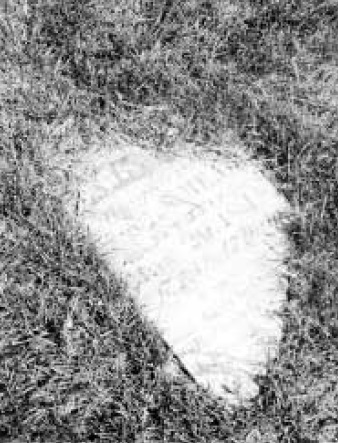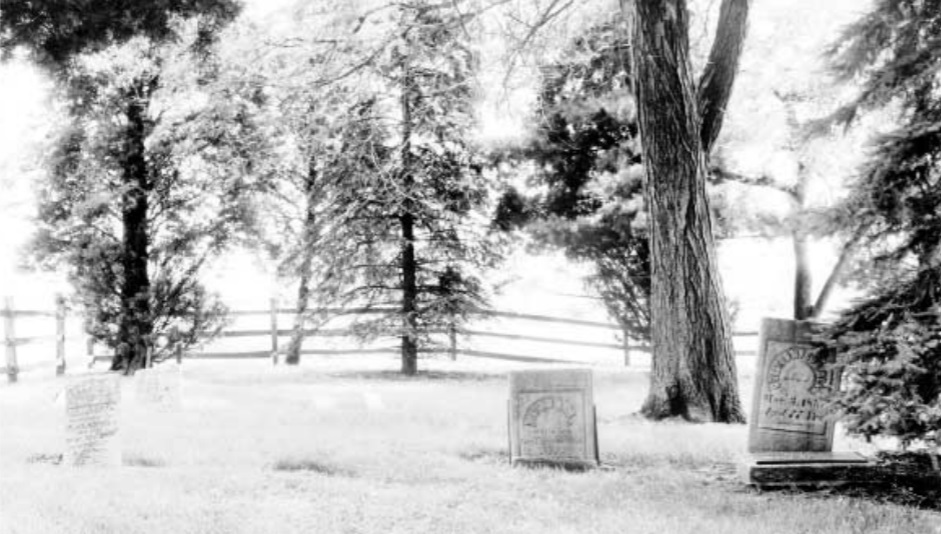Pioneer Cemetery
Batavia’s retired postmaster, Augie Mier, discovered an abandoned cemetery—and saved it from ruin.
Tucked away in a quiet corner of Fermilab’s high-energy world lies a 2,500-square-foot parcel of land known as “Pioneer Cemetery.” Wind whispers through the evergreens, lending the fenced, neatly trimmed area a sense of protected serenity. But the condition of the cemetery’s 18 grave markers reveals its former neglect. Broken pieces of the stones peak through the grass. Over 150 years of wind, snow, mud and hail have rendered the inscriptions on nearly half of the surviving sandstone markers illegible. Worn by time and overgrown by nature, the cemetery might have disappeared, if not for the efforts of one Batavia man.
A soldier’s grave
Former Batavia postmaster Augie Mier, who donated an extensive collection of American Indian artifacts to Fermilab, stumbled across the cemetery while rabbit hunting in 1907. Obscured by a prickly tangle of raspberry bushes, the abandoned plot appeared to contain about 40 headstones. The young man took particular interest in one marked “General Thompson Mead... Died March 3, 1851. Aged 77 years.”
Thompson Mead, the son of a revolutionary soldier, served the New York state militia as a lieutenant colonel in the War of 1812. When his regiment, outnumbered by over 1,000 Indians and British troops, faced surrender in the Battle of Queenstown Heights, Mead hid his sword on a rock-strewn bluff to keep it from enemy hands. Ironically, the terms of surrender would have allowed him to keep the weapon. When accused of disarming himself out of fear, Mead offered to prove his courage against any willing to challenge it. Some time later, after being named “General” in the state militia, he began a career as county sheriff.
After retiring as sheriff and spending time in state politics, Mead moved from his native New York to Batavia. There, he joined his son’s family and established a 29-acre homestead in 1845. Following a common practice, the Meads used a previously established cemetery in their pasture as the family’s burial ground.
While the earliest recorded burial there occurred in 1839, all seven of the cemetery’s headstones that display dates reveal deaths between 1848 and 1851, most likely from a cholera epidemic. Many occurred in youth. Agnes Mead, the general’s granddaughter, died at the age of seven months and 17 days in 1848. Henrietta, her sister, followed only three years later. A poem on the two-year-old’s headstone describes the tragedy: “She woke the cup of life to sip / Too bitter ‘twas to drain / She merely touched it to her lips / And then she slept again.”
No longer abandoned
Pioneer Cemetery was formerly called “Blackhawk War Cemetery” because of a mistaken belief that General Mead fought in an 1830s Illinois war against the Sac and Fox Indians led by Chief Black Hawk. Historical evidence indicates that Mead was still in New York at the time, however. Another stray piece of local lore holds that Mead received the land from the government as a reward for his wartime services. But records provided by Fermilab Archivist Adrienne Kolb show that he purchased the land at a cost of $321.97 from a private seller.
Inaccuracies about Pioneer Cemetery abound, but one certainty remains: if not for Mier’s discovery and his later efforts, the place might have fallen into ruin. His discovery of Mead’s grave in 1907 prompted the patriotic young man to begin placing a flag there every Memorial Day. While he served overseas in World War I, neighborhood children continued the practice.
Mier and Ernest Lundine, another Batavia man interested in the abandoned cemetery, began a campaign to raise interest in Pioneer Cemetery. After 20 years of knocking on the wrong doors, in 1954 they persuaded the Warrenville American Legion to establish an annual custom of decorating the general’s grave. In 1958, with the permission of Mrs. H. A. Phillips, owner of the surrounding farm, they engaged the help of the Kane County Veterans of Foreign Wars to clear the area and unearth fallen grave stones. Giving the general’s grave the same recognition as other U.S. soldiers’, they later installed a bronze plaque to honor him. Then, in 1972, with the cooperation of Fermilab, they rededicated the cemetery in a ceremony complete with official speakers, a drum and bugle corps, and the raising of a flag that had flown over the White House.
Preserving a piece of history
Ninety-one years ago, when Mier discovered the abandoned cemetery, he counted about 40 headstones crowding its bramble-choked thicket. Speculation puts the original number closer to 50 on a plot of land that once covered nearly a full acre. Sadly, nature and time don’t fully account for its diminished size. Located on what used to be farm land, many of the cemetery’s headstones have been knocked down or broken over the years by farm animals. Others were apparently removed by local farmers for use as stepping stones or other building materials. Now, a number of unmarked graves may even exist under the old Batavia Road and other areas outside the cemetery’s boundaries.
People have suggested replacing the headstones with new, more durable markers and preserving the originals in a historical display, like the one devoted to Indian artifacts in Wilson Hall. However, according to Dave Gassman, Fermilab’s chief legal counsel, state law restricts Fermilab to performing only basic maintenance, such as mowing the grass. Although the land itself is federal property, exceptions stated in the original transfer of the property from Illinois place artifacts there under the interests of the state and possible descendants of the deceased. To restore the cemetery, Fermilab would first have to obtain a permit from the State Historic Preservation Society, the cemetery’s trustee.
For now, according to Roads and Grounds Manager Bob Hall, the only plan in motion calls for basic upkeep, such as repairing the fence and propping up some of the markers. DOE has said that as long as it owns the Laboratory, it will care for the grounds and maintain the integrity of the site. While reaching toward the particle physics of the future, then, Fermilab holds onto this valuable relic of the past.






